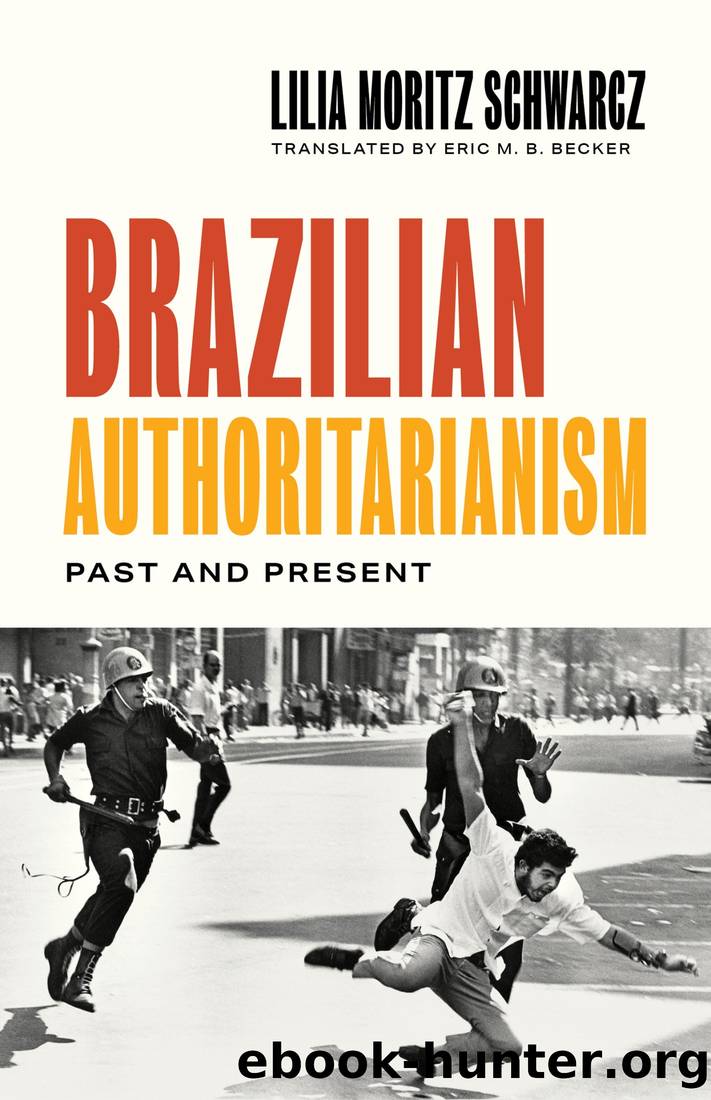Brazilian Authoritarianism by Lilia Moritz Schwarcz;

Author:Lilia Moritz Schwarcz; [Schwarcz;, Lilia Moritz]
Language: eng
Format: epub
ISBN: 9780691210919
Publisher: Princeton UP
Published: 2022-04-27T00:00:00+00:00
And so, through stealth, the message spread that those who assimilated to White supremacy could be regarded as ânoble savages,â while those who revolted appeared to be following a wrong turn on the road to civilization. It is a specific and selective way of viewing history, which values those who did not struggle for their rights and discriminates against peoples who rebelled and did not accept the invasion of their lands, their properties, and their cultures.
The problem is that such a perspective, as romanticized as it is violent, has been endlessly perpetuated in Brazil, to the extent that the Indigenous were among those systematically excluded from the First Republic beginning in 1889. Even if during the Empire interest was more rhetorical than pragmatic, and if native peoples figured more prominently in Romantic novels and historical portraiture than in concrete policy decisions, with the advent of the Republic this erasure would become even more evident. A perfect example is the massacre of the Kaingang in 1905, to make way for the Northwest Railway of Brazil. At the time, the scientist Hermann von Ihering, then director of the Museu Paulista, went to the press to defend the extermination of this tribe. The advance toward civilization must not be derailed, he brayed, publicly explaining his vision that the Indigenous, never considered to be landowners or friendly neighbors, were a sort of human impediment.
The process of demarcation of Guarani, Xavante, and Kaingang land began while the country still found itself under Dom Pedro IIâs rule, more precisely in the year 1880. While the first two of these nations were âintegrated,â even at the cost of nearly being decimated, at least in their form at that time, the last fought valiantly against the invasion of its lands. The situation was not brought under control until 1911, and then thanks to the intervention of the Indian Protection Service, but only after the Kaingang had practically been wiped out. Heading up the Indian Protection Service was Cândido Mariano Rondon, a veteran of the military and the backcountry, who, starting in 1890, installed telegraph lines in the Midwest region of the country all the way up to the Amazon. Already in that era, the republican government paid close attention to the area, which remained isolated from the urban centers and was located in a strategic border zone. The solution was to seek the âintegrationâ of Indigenous peoples, mapping the locale, domesticating their lands, and seeking to establish contact with them.
In each region the policy toward such lands was different, however, not least because, we may recall, there existed both areas considered ânewââsuch as the Amazon, ârediscoveredâ on account of the expansion of the rubber tradeâand other areas, previously colonized. In either case, around the beginning of the twentieth century the âIndigenous questionâ was slowly moving on from being one of labor, only to soon be reconfigured as a land ownership problem. In the case of long-established villages, the order was to control their size. On the frontiers or
Download
This site does not store any files on its server. We only index and link to content provided by other sites. Please contact the content providers to delete copyright contents if any and email us, we'll remove relevant links or contents immediately.
| Argentina | Bolivia |
| Brazil | Chile |
| Colombia | Ecuador |
| Guyana | Paraguay |
| Peru | Suriname |
| Uruguay | Venezuela |
Cat's cradle by Kurt Vonnegut(15182)
Pimp by Iceberg Slim(14393)
4 3 2 1: A Novel by Paul Auster(12281)
Underground: A Human History of the Worlds Beneath Our Feet by Will Hunt(12022)
The Radium Girls by Kate Moore(11921)
Wiseguy by Nicholas Pileggi(5669)
Perfect Rhythm by Jae(5324)
American History Stories, Volume III (Yesterday's Classics) by Pratt Mara L(5256)
The Fire Next Time by James Baldwin(5248)
Paper Towns by Green John(5087)
Pale Blue Dot by Carl Sagan(4909)
A Higher Loyalty: Truth, Lies, and Leadership by James Comey(4843)
The Mayflower and the Pilgrims' New World by Nathaniel Philbrick(4421)
The Doomsday Machine by Daniel Ellsberg(4415)
Killers of the Flower Moon: The Osage Murders and the Birth of the FBI by David Grann(4385)
The Sympathizer by Viet Thanh Nguyen(4305)
Too Much and Not the Mood by Durga Chew-Bose(4270)
The Borden Murders by Sarah Miller(4247)
Sticky Fingers by Joe Hagan(4100)
